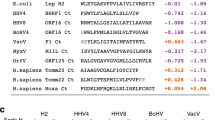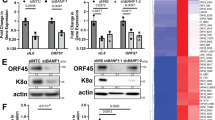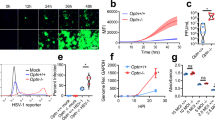Abstract
LITTLE is known about virus–host cell interactions that regulate the lytic potential of viruses during productive replication. Sindbis virus (SV), a single-stranded positive-sense RNA virus in the alphavirus genus (family Togaviridae), results in lytic infection in most vertebrate cell lines, but persistent productive infection in post-mitotic neurons1. The cellular oncogene bcl-2, which encodes an inner mitochondrial membrane protein of Mr 26,000 (ref. 2), blocks programmed cell death (apoptosis) in neurons3. We therefore investigated whether SV infection induces programmed cell death in non-neuronal cells, and if so, whether virus-induced programmed cell death can be blocked by transfection with bcl-2. We demonstrate that SV infection of baby hamster kidney (BHK-2), mouse neuroblastoma (N18), and rat prostatic adenocarcinoma (AT-3) cells results in programmed cell death, whereas SV infection of bcl-2-transfected AT-3 cells results in long-term persistent productive infection. Thus cellular bcl-2 oncogene expression plays a role in the establishment of persistent viral infection by blocking virus-induced programmed cell death.
This is a preview of subscription content, access via your institution
Access options
Subscribe to this journal
Receive 51 print issues and online access
$199.00 per year
only $3.90 per issue
Buy this article
- Purchase on Springer Link
- Instant access to full article PDF
Prices may be subject to local taxes which are calculated during checkout
Similar content being viewed by others
References
Levine, B. et al. Science 254, 856–860 (1991).
Hockenbery, D., Nunez, G., Milliman, C., Schreiber, R. D. & Korsmeyer, S. J. Nature 348, 334–336 (1990).
Garcia, I., Martinou, I., Tsujimoto, Y. & Martinou, J. C. Science 258, 302–304 (1992).
Terai, C., Kornbluth, R. S., Pauza, C. D., Richman, D. D. & Carson, D. A. J. clin. Invest. 87, 1710–1715 (1991).
Laurent-Crawford, A. G. et al. Virology 185, 829–839 (1991).
Rao, L. et al. Proc. natn. Acad. Sci. U.S.A. 89, 7742–7746 (1992).
Wylie, A. H., Kerr, J. F. R. & Curie, A. R. Int. Rev. Cytol. 68, 251–306 (1980).
Arends, M. J. & Wylie, A. H. Int. Rev. exp. Path. 32, 223–254 (1991).
Johnson, R. T., McFarland, H. F. & Levy, S. E. J. infect. Dis. 125, 257–262 (1972).
Martin, D. P. & Johnson, E. M. Jr in Apoptosis: The Molecular Basis of Cell Death (eds Tomei, L. D. & Cope, F. O.) 247–261 (Cold Spring Harbor Laboratory Press, New York, 1991).
Server, A. C. & Mobley, W. C. in Apoptosis: The Molecular Basis of Cell Death (eds Tomei, L. D. & Cope, F. O.) 263–278 (Cold Spring Harbor Laboratory Press, New York, 1991).
Negrini, M., Silini, E., Kozak, C., Tsujimoto, Y. & Croce, C. M. Cell 49, 455–463 (1987).
Hockenbery, D. M., Zutter, M., Hickey, W., Nahm, M. & Korsmeyer, S. J. Proc. natn. Acad. Sci. U.S.A. 88, 6961–6965 (1991).
Froshauer, S., Kartenbeck, A. & Helenius, A. J. Cell Biol. 107, 2075–2086 (1988).
Buchmeier, M. J., Welsh, R. M., Dutko, F. J. & Oldstone, M. B. A. Adv. Immun. 30, 275–331 (1980).
Clem, R. J., Fechmeimer, M. & Miller, L. K. Science 254, 1388–1390 (1991).
Henderson, S. et al. Cell 65, 1107–1115 (1991).
Gregory, C. D. et al. Nature 349, 612–614 (1991).
Chou, J. & Roizman, B. Proc. natn. Acad. Sci. U.S.A. 89, 3266–3270 (1992).
Nunez, G. et al. J. Immun. 144, 3602–3610 (1990).
Martikainen, P., Kyprianou, N., Tucker, R. W. & Isaacs, J. T. Cancer Res. 51, 4693–4700 (1991).
Sorensen, C. M., Barry, M. A. & Eastman, A. J. natn. Cancer Inst. 82, 749–755 (1990).
Tsujimoto, Y. & Croce, C. Proc. natn. Acad. Sci. U.S.A. 83, 5214–5218 (1986).
Levine, B. & Griffin, D. E. J. Virol. 66, 6429–6435 (1992).
Reed, J. C., Cuddy, M., Slabiak, T., Croce, C. M. & Nowell, P. C. Nature 336, 259–261 (1988).
Cepko, C., Roberts, B. & Mulligan, R. Cell 37, 1063–1062 (1984).
Trieger, B. & Isaacs, J. J. Urol. 140, 1580–1586 (1988)
Reed, J. C. et al. Cancer Res. 51, 6529–6538 (1991).
Author information
Authors and Affiliations
Rights and permissions
About this article
Cite this article
Levine, B., Huang, Q., Isaacs, J. et al. Conversion of lytic to persistent alphavirus infection by the bcl-2 cellular oncogene. Nature 361, 739–742 (1993). https://doi.org/10.1038/361739a0
Received:
Accepted:
Issue Date:
DOI: https://doi.org/10.1038/361739a0
This article is cited by
-
Challenges of bacteriophages application in controlling bacterial plant diseases and how to overcome them
Journal of Genetic Engineering and Biotechnology (2023)
-
Visualization of cell-type dependent effects of anti-E2 antibody and interferon-gamma treatments on localization and expression of Broccoli aptamer-tagged alphavirus RNAs
Scientific Reports (2020)
-
Sindbis viral structural protein cytotoxicity on human neuroblastoma cells
Pediatric Surgery International (2020)
-
Alphavirus Encephalomyelitis: Mechanisms and Approaches to Prevention of Neuronal Damage
Neurotherapeutics (2016)
-
Protective and Pathogenic Responses to Chikungunya Virus Infection
Current Tropical Medicine Reports (2015)
Comments
By submitting a comment you agree to abide by our Terms and Community Guidelines. If you find something abusive or that does not comply with our terms or guidelines please flag it as inappropriate.



